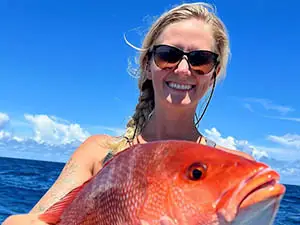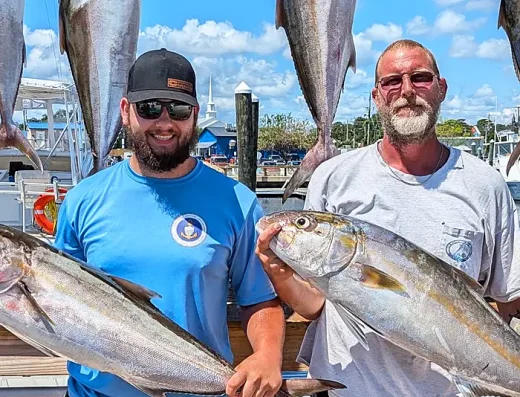Carolina Beach Fishing Charters
Carolina Beach fishing charters work the Cape Fear River, Intracoastal Waterway, and Atlantic nearshore reefs for red drum, speckled trout, flounder, king mackerel, and offshore tuna
Top Rated Charters in Carolina Beach
TrustedFish connects anglers with proven local captains in Carolina Beach, North Carolina —no commissions, no pay-to-play listings, no BS. Every charter on our platform is invite-only, vetted for skill, local knowledge, and reputation. If they’re listed, they’ve earned it.
Carolina Beach, NC Fishing Guide
Carolina Beach offers one of the most diverse fisheries along the North Carolina coast, with options ranging from half-day inshore charters to multi-day bluewater runs. Inshore trips typically stay close to the marsh creeks, Cape Fear River, and Snow’s Cut, where anglers target red drum, speckled trout, and flounder on light tackle or fly gear. Nearshore charters often run 5 to 15 miles to hard-bottoms, wrecks, and artificial reefs where king mackerel, Spanish mackerel, and cobia show up in numbers, along with bottom fish like black sea bass and grunts. Offshore charters head 30 to 60 miles to the Gulf Stream for mahi, tuna, and billfish, a full-day or extended-day commitment.
The main launch points are the Carolina Beach Municipal Marina and private ramps off the Intracoastal Waterway, giving quick access to both river and ocean. Run times vary: inshore spots can be reached in under 15 minutes, while Gulf Stream runs require a couple of hours. Seasonal shifts are pronounced here: spring brings drum and trout inshore, summer heats up the mackerel bite nearshore, fall offers excellent mixed action in both shallow and deep water, and winter narrows to trout and drum around deeper creeks and channels.
Techniques depend on the trip—light tackle jigging with soft plastics and live shrimp dominates the backwaters, trolling with ballyhoo or spoons is standard offshore, and vertical jigging or bottom rigs take care of reef species. Night fishing for speckled trout and drum is also popular in the warmer months. Nearby waters like Wrightsville Beach and Southport provide alternate launch options, but Carolina Beach’s location gives it direct access to both Cape Fear River backwaters and the Gulf Stream highway
Fishing Seasons in Carolina Beach
Spring
Spring at Carolina Beach starts with red drum moving along the marsh banks and speckled trout feeding in the creeks. Flounder begin showing as waters warm, and nearshore reefs start producing Spanish mackerel by April. Most charters this season run half-day inshore trips, working popping corks with live shrimp or soft plastics. On the nearshore side, trolling Clark spoons and small plugs gets steady action. Wind can be a factor, but protected waters in the Cape Fear system keep fishing consistent.
Summer
Summer shifts the focus offshore and nearshore. King mackerel, mahi, and cobia are prime targets, with charters running to 10–30 miles offshore. Trolling live menhaden for kings is a staple, while dolphin are taken on ballyhoo rigs farther out. Inshore, red drum remain active, with early mornings and late evenings producing the best topwater bites. Night charters gain popularity, especially for trout and drum along lit docks. Heat pushes many anglers toward longer offshore runs to beat the inshore slump.
Fall
Fall is arguably the best season at Carolina Beach. Cooling waters fire up red drum in the surf and marshes, with larger schools patrolling the inlets. Speckled trout peak in October and November, and flounder provide consistent action along structure. Nearshore, false albacore and Spanish mackerel blitz bait pods, while offshore trolling for wahoo and blackfin tuna heats up. Charters this time of year see a balance of half-day inshore trips and long offshore runs, with live bait, jigs, and trolled ballyhoo all producing.
Winter
Winter narrows the fishery but doesn’t shut it down. Red drum hold in deep holes of the Cape Fear River and Snow’s Cut, and speckled trout can be caught in creeks with soft plastics worked slowly. Some anglers run nearshore for sea bass and tautog when weather allows. Most trips this season are shorter half-day charters focused inshore, where shelter from wind and cold water makes fishing manageable. Techniques shift to lighter jigheads and slower retrieves, with a focus on deep structure.
Gamefish in Carolina Beach
- Red Drum – 18–40 inches. Found along marsh edges, docks, and surf zones in spring and fall, best on live bait or topwater plugs
- Speckled Trout – 14–24 inches. Caught in creeks and river mouths year-round, peaking in fall on soft plastics and MirrOlures
- Flounder – 14–24" Targeted from late spring through early fall. Found around sandy drop-offs, jetty rocks, and docks using live mullet or soft plastics.
- King Mackerel – 10–30 pounds. Nearshore reefs and hard-bottoms in summer and fall, best on slow-trolled live menhaden.
- Spanish Mackerel – 1–5 pounds. Nearshore trolling in spring through fall with spoons and planers.
- Cobia – 20–60 pounds. Caught around buoys and bait schools in late spring and early summer, sight-cast or live-baited.
- Mahi-Mahi – 10–30 pounds. Offshore Gulf Stream trips in summer, taken on trolled ballyhoo and skirted lures.
- Blackfin Tuna – 15–30 pounds. Fall offshore trips, caught trolling or jigging around temperature breaks.
Carolina Beach Fishing FAQs
What are the main launch points in Carolina Beach?
Most charters leave from the Carolina Beach Municipal Marina, with additional private ramps along the Intracoastal Waterway for inshore trips.
How long are typical fishing trips?
Half-day trips run 4–5 hours inshore, full-day charters go 8–10 hours, and offshore Gulf Stream trips can last 12 hours or more depending on distance.
What gear is provided by local charters?
All tackle, bait, and safety equipment are included. Captains also handle licensing, so anglers only need to bring food, drinks, and sun protection.
Do I need a fishing license?
No, fishing licenses are covered under the captain’s blanket license for both inshore and offshore waters.
What’s the best time of year to fish Carolina Beach?
Fall is considered the prime season with excellent inshore and offshore action, but spring and summer also provide diverse opportunities.
Which techniques are most common on charters here?
Light tackle with live shrimp or artificials dominates inshore, trolling and drifting live bait is key nearshore, and offshore crews troll ballyhoo or vertical jig.
What species can I expect on a half-day trip?
Half-day inshore charters usually target red drum, trout, and flounder. Nearshore half-days often produce Spanish mackerel and king mackerel.
Can groups or families book charters?
Yes. North Carolina requires a license, but any charter operating legally will have you covered under their blanket license.
Are specialty trips like night fishing available?
Yes, many captains offer night trips in summer targeting speckled trout and red drum around docks, bridges, and lighted structure.


